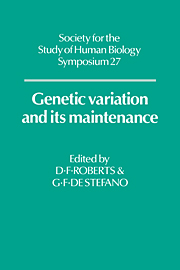Book contents
- Frontmatter
- Contents
- Preface
- Part I Genetic Diversity - Its Dimensions
- Genetic polymorphisms - a widening panorama
- Some implications of improved electrophoresis techniques for population genetics
- HLA variation in the tropics
- Chromosome polymorphism in humans
- Restriction fragment length polymorphisms in the human genome
- Nucleotide sequences, restriction maps, and human mitochondrial DNA diversity
- Mitochondrial DNA variation in eastern highlanders of Papua New Guinea
- The Contribution of polymorphisms in mtDNA to population genetic studies
- Part II Genetic Diversity - Its Origin and Maintenance
- GENETIC DIVERSITY - APPLICATIONS AND PROBLEMS OF COMPLEX CHARACTERS
- Index
Mitochondrial DNA variation in eastern highlanders of Papua New Guinea
Published online by Cambridge University Press: 05 March 2012
- Frontmatter
- Contents
- Preface
- Part I Genetic Diversity - Its Dimensions
- Genetic polymorphisms - a widening panorama
- Some implications of improved electrophoresis techniques for population genetics
- HLA variation in the tropics
- Chromosome polymorphism in humans
- Restriction fragment length polymorphisms in the human genome
- Nucleotide sequences, restriction maps, and human mitochondrial DNA diversity
- Mitochondrial DNA variation in eastern highlanders of Papua New Guinea
- The Contribution of polymorphisms in mtDNA to population genetic studies
- Part II Genetic Diversity - Its Origin and Maintenance
- GENETIC DIVERSITY - APPLICATIONS AND PROBLEMS OF COMPLEX CHARACTERS
- Index
Summary
INTRODUCTION
Studies of genetic variation in humans have contributed much to knowledge of the history and evolution of our species (Mourant et al, 1976; Nei & Roychoudhury, 1982; Ammerman & Cavalli-Sforza, 1985; Nei, 1985), providing a quantitative and temporal framework that is generally unavailable from other types of evidence. This is particularly true for studies of human population structure and migration in the South Pacific (Kirk, 1980a, 1982; Serjeantson, 1985). However, the variables typically employed in such studies (blood group and histocompatibility antigens, serum proteins, red cell enzymes, etc.) are inherited from both parents, and their recombination further obscures already complex patterns of variation that reflect historical interactions between such forces as mutation, selection, drift, migration, invasion, and extinction. Thus multiple interpretations are possible of the patterns of variation observed in these products of nuclear genes. To circumvent some of these problems, an alternative approach is to study restriction site polymorphisms in human mitochondrial DNA (mtDNA).
There are a number of advantages to studying mtDNA. The molecule is circular and small, about 16,500 base pairs (bp), and present in high copy number, so that it can be readily purified and analyzed by mapping with restriction enzymes. It is perhaps the best-known piece of eukaryotic DNA, with the complete nucleotide sequence and gene organization known from five species, including a human (Anderson et al, 1981). Knowledge of one human sequence facilitates high-resolution mapping of restriction enzyme sites in other human mtDNAs. This permits study of the nature and location of nucleotide substitutions and length mutations that have accumulated in the mtDNA molecule (Cann & Wilson, 1983; Cann et al, 1984).
- Type
- Chapter
- Information
- Genetic Variation and its Maintenance , pp. 87 - 100Publisher: Cambridge University PressPrint publication year: 1986
- 3
- Cited by



